
Two St Helens, two different churches
Less than three miles apart lie two churches, each one dedicated to St Helen. Yet the contrast between them could not be more different. One oozes antiquity, the other has a history rooted in the 19th and 20th Century. The first church, at Escrick, lies on the main A19 road between Selby and York, and demands to be visited. Skipwith lies a couple of miles to the south west, on a quieter side road, and the church itself is tucked away at the end of another even quieter road.
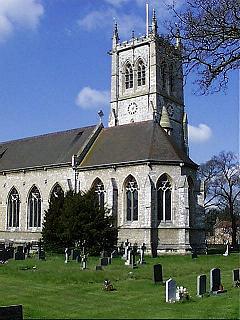
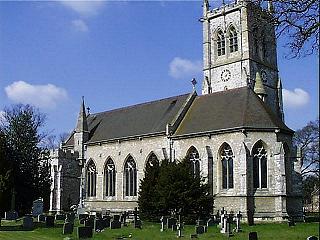
This is pretty much the view from the main road, taken from the lych-gate entrance to the large churchyard, and probably all most people see. As I drove by on the Wednesday morning, I made a mental note to stop on the way back south on the Friday.
This is not the site of the medieval church of Escrick. This was to the south-east, alongside Escrick Hall (the former manor house), which can be seen from the road to Skipwith as you leave the village. The Hall is now St Margaret's School (for Girls) which moved here in 1949. W.E.Reader, writing in the short church guidebook, says "in 1781, by a private Act of Parliament, the site of the church was granted to Beilby Thompson to further his plans for improvements to the surrounds of the Manor House, on condition he built a new church elsewhere. In consequence, the church and rectory were demolished and replaced by an ice-house and a new church built on the present site." This Classical church was replaced again by the present building to the designs of F.C.Penrose 1856-7.
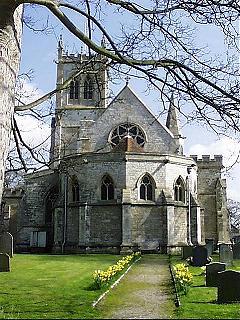
If you are a good person like me, and use the church car park, this is the view that awaits you as you walk towards the church. The church is unusual, having a six-sided west baptistry, a large circular rose window for the west end of the nave, a large two-storeyed south-west porch, the upper room reached by a stair housed in a turret topped by a stone spire. The tower, approximately 100 feet (30.5 metres) high, stands to the north of the chancel, and there is an outer bay to the north-east of the north aisle which serves as a vestry (this added in 1896). Add today's Spring sunshine and two rows of daffodils, and it makes a splendid picture.
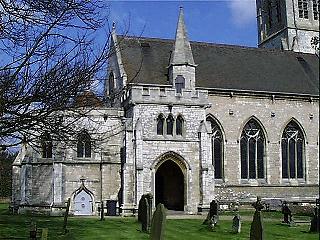
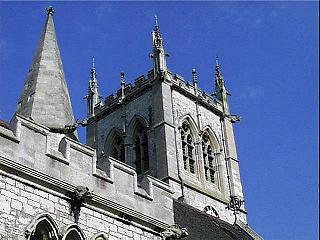
This shows another view of the west end of the church. The quality of the workmanship shines through. As you head towards the porch glance up again at the tower and spirelet. Gargoyles spout forth from the base of the embattled parapet. Sadly the interior of the porch, although it has a stone roof, is disappointing.
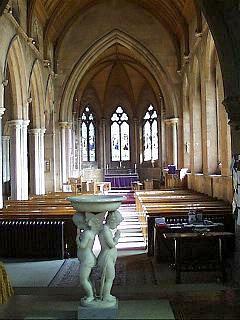
The interior is wide, light and spacious, as this view from the west end to the chancel shows. A row of stately three-light Decorated windows echo the fine five-bayed north arcade opposite. The woodwork is all light-coloured and of a single period, and the main roofs are also of wood. Sadly a huge tragedy struck the church on 5th February 1923 when the church was gutted by fire. The church was restored by the architect John Bilson and reopened on 25th March 1925. The fire gave the magnesium and oolitic limestone of the original walls a pink tinge, so the repairs were done with Ancaster stone which has a similar natural hue.
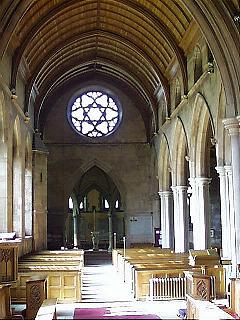
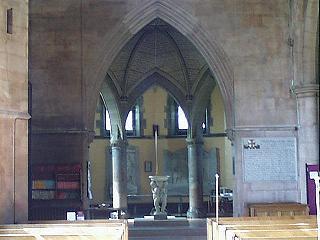
The fine proportions can again be seen looking west from the high altar, spoilt only by the odd internal projection of the stair turret to the upper room of the porch. Here too you can see the unusual interior of the baptistry, because it is not only vaulted (in brick) but has a vaulted ambulatory, with an arcade carried on polished Devonshire marble pillars, both pink and black. This is built over the only surviving part of the 1781 church, the family burial vault of the Lords of the Manor (Thompson, and later Lawley family who received the title of Baron Wenlock from 1839). Their memorials adorn the walls of the ambulatory, although some are hidden behind display boards for the present day congregation.
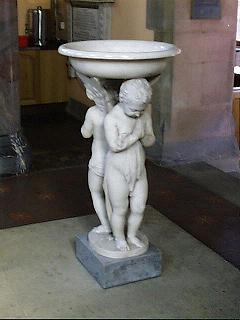
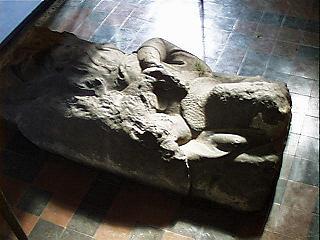
In pride of place however is the charming font by Giovanni Tognoli of Rome, 1844. It stood in the former church. Two winged cherubs stand praying back-to-back with their wings and heads supporting the bowl. Behind placed directly on the tiled floor (and under a ugly C20 table) is the one survivor from the original village church, a mutilated effigy of a C14 (reputedly Sir Thomas de Lancelles d.1324), which was originally placed in the ogee headed recess in the south wall outside of this baptistry.
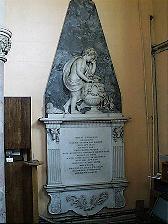
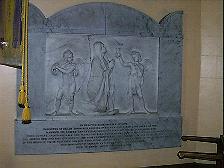
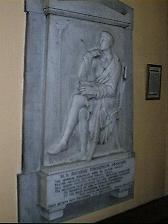
Three of the memorials in this mortuary chapel are shown above. On the left Beilby Thompson d1799 (note the owl to the left of the putto's feet), centre Jane, Lady Lawley d1816 (made by the Danish sculptor Bertel Thorwaldsen showing her kneeling between two child angels one with a scroll and the other with an hourglass), and right Richard Thompson d1820 by Matthew Cotes Wyatt c1834.
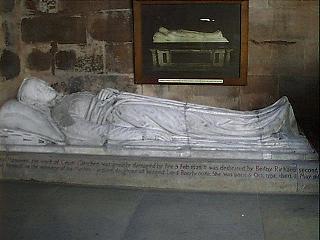
The final monument shown is to Caroline, Lady Wenlock d1868. This is now at the west end of the north aisle, on the floor, where appreciation of the fine workmanship is difficult. The original state of the monument is shown in a photograph on the wall behind, and it stood under the second arch of the arcade. The 1923 fire badly damaged the memorial and the effigy split into three pieces. It was made by Count Gleichen (otherwise Admiral the Prince Victor of Hohenlohe-Langenburg who was a cousin of Queen Victoria) and erected in 1876.
St Helen's Church, SKIPWITH
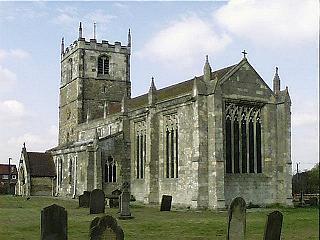
The second St Helen's lies a little to the west of the main through-road and the village pond and its two pubs. The first view which you get approaching this way shows the stately chancel, one of the main reasons for the church's inclusion in learned texts on architecture. This is early Decorated work of c1300, and made unusual in that all of the windows are straight-headed yet have fine tracery. However this is really the culmination of the church's architecture, in fact after parking up and approaching the church from the west a much different age of architecture is clearly evident.
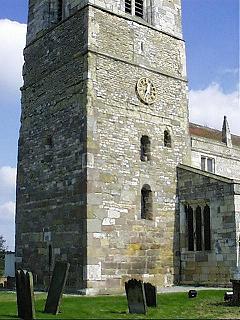
The top of the tower is clearly C15 work, but was the second heightening of a much older structure. The very base of the tower was originally the porch to the Anglo-Saxon church here. It has splayed windows. It was converted into a tower early in the C11 by raising this bottom stage and adding a second above a stringcourse where traces of two-light bell-openings can still be seen.
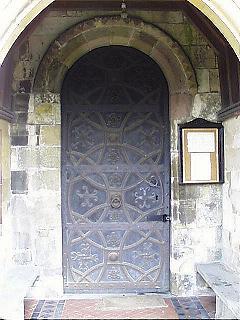
Approaching the entrance via the C19 S porch, a Norman doorway is seen but it is the south door itself that must be inspected. This has the experts in a turmoil, for although the door itself seems C19, the ironwork is either a very clever imitation or original C13 craftsmanship, in part restored. I shall not offer any opinion, other than to say it looks convincing to me and is very pretty anyhow!
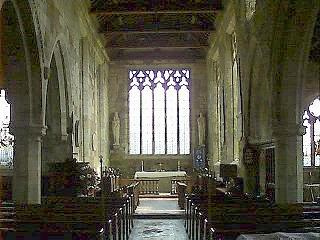
The interior is made ificult to photograph due to the flood of light coming from the chancel. The stained glass which was here has all been removed, including the early C14 glass mentioned in the 1995 edition of the Buildings of England Yorkshire: York and the East Riding volume. This has been taken away to save it from damage from mining subsidence...... something which hopefully will not mean the loss of this church too in time to come. The east window is flanked by modern statues of St Helen and St Simon Zelotes, 1965 by Eric Winters.
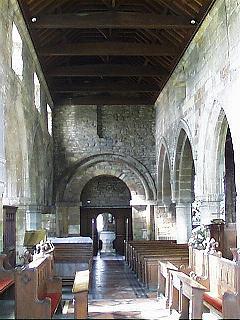
Looking west is a different matter however and the sheer bulk of the Anglo-Saxon tower arch (probably pre-1000) can be appreciated. You can also see the successive enlargement of the original church. Firstly a two-bayed north aisle was added to the nave, followed by a similar south aisle. The east bays of the nave were added presumably around the time the decision was taken to build the magnificent chancel. A surprise though is the absence of a chancel arch. The clerestory is the latest part of the main church, probably added when the tower was raised again. The south aisle itself is C14, but the north aisle was rebuilt in the C16.
A carved stone, which I did not see, is built into the tower internal wall, which shows the Destruction of the Norse Gods at Ragnarök. The church lacks much else of interest. Most of the noteworthy medieval gravestones have been used to cap the churchyard walls! In the chancel there are modern memorial tablets carved by Lawrence Whistler,c1957-82.
So ended my vist to the two St Helen's and after a brief stop at the magnificent Selby Abbey (and a wonderful piece of pie from a cakeshop "Cy's Pies" **Recommended**) there, I was back on the 200-mile trip back to Bristol.